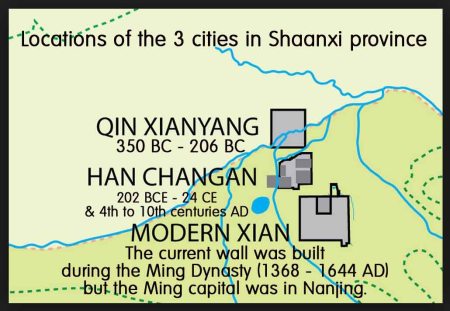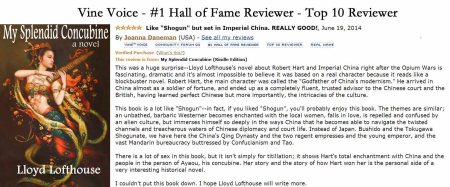China’s Ancient Capital: Part 1 of 5
Most people outside of China only know of Beijing—first known as Peking—as the capital of China. However, another city was China’s capital for more than a thousand years, and more than 4,000 historical sites and tombs have been excavated there.
That city was Chang’an and it served as the capital of China from the Han to the Tang Dynasty spanning more than eleven hundred years. It was also the cultural center of the Silk Road.
In 2008, the last time we visited Xi’an (near the original site of Chang-an), subway construction was running behind schedule due to a law that does not allow the destruction of historical sites such as the tombs of emperors. There are so many of these tombs below ground that the subway tunnels must be diverted to avoid them causing construction delays.
This is the first part of a documentary about Xian produced by the Discovery Channel. I watched the five-part series on You Tube in 2011 but only found Part 1 to share with this series of Blog post.
To learn about Chang’an and Xi’an’s also teaches us a lot about China’s civilization.
In the Discovery Channel’s documentary, Neville Gishford said, “It (Han Chang’an) was more powerful than Rome. If any Roman army had actually gone there, they would have been absolutely annihilated.”
The city of Han Chang’an was larger than Constantinople and richer than Egypt’s Alexandria.
Today, another city called Xi’an, near the original location of Chang’an, is home to millions of people and thousands of men made of clay, the Terra Cotta Warriors guarding China’s first emperor.
In addition, the current massive city wall for Xi’an is more than six hundred years old and longer than 12 kilometers. Cracks are appearing and an engineering team keeps close watch and makes repairs
Soon after the Qin Dynasty capital of Xianyang was destroyed, the Han Dynasty built the second city Chang’an, which is close to the modern city of Xi’an, and the old eroding walls of Chang’an are still visible.
Covering 36 square kilometers, Han Chang’an (202 BCE – 24 CE and again in the 4th to 10th centuries AD) was more than one and a half times the size of Rome.
Continued January 27, 2016 in Part 2
______________________________
Lloyd Lofthouse is the award-winning author of My Splendid Concubine [3rd edition]. When you love a Chinese woman, you marry her family and culture too. This is the unique love story Sir Robert Hart did not want the world to discover.
Subscribe to “iLook China”!
Sign up for an E-mail Subscription at the top of this page, or click on the “Following” tab in the WordPress toolbar at the top of the screen.


Anybody interested in history can’t overlook the ancient Chinese capital of Chang’an! Very influential and important city of the past, not just for Asia, but for the West as well! Interesting posts about the city.
Thank you. I’ve read some of the debates online over who had more power, the Roman Empire or the Han Dynasty.
The Han Dynasty in 50 BC covered an area of 6 million km2 or 2,316,613 sq mi. It had a population of more than 57 million, and China had the most advanced agricultural and irrigation methods in the world. While Rome had its aqueducts that carried water but not people, China had the Grand Canal that was started centuries before the birth of Jesus Christ, and it was China that invented the Pound Lock allowing boats and barges to move over mountains by raising and lowering the water levels in the locks. The construction of the Grand Canal started in the 5th century BC and wasn’t completed until the 6th/7th century AD. The Pound lock came later after the more than 1,000 mile long canal was completed.
By comparison, the Roman Empire in 26 BC controlled 2,750,000 km2 or 1,061,781 sq mi with a population of 56.8 million.
The Han Dynasty (206 BCE-220 CE) was one of the longest of China’s major dynasties. In terms of power and prestige, the Han Dynasty in the East rivalled its almost contemporary Roman Empire in the West. With only minor interruptions it lasted a span of over four centuries and was considered a golden age in Chinese history especially in arts, politics and technology. All subsequent Chinese dynasties looked back to the Han period as an inspiring model of a united empire and self-perpetuating government.
The opening of the Silk Road was probably the major economic achievement of the Han Dynasty. Emperor Wu took the initiative to set out on diplomatic missions to various rulers in Central Asia. This led to the exploration of trade routes that linked Xi’an to the Levant coast on the Mediterranean and opened up new roads for merchants. This increased the trade and economic prosperity of the empire and also led to a constant cultural exchange between several cultures.
The Qin and Han militaries used the most advanced weapons of the time. The sword, first introduced during the chaos of the Warring States Period became a favorite weapon. The Qin began producing stronger iron swords. Crossbows were also improved, becoming more powerful and accurate then even the compound bow. Another Chinese innovation allowed a crossbow to be rendered useless simply by removing two pins, preventing enemies from capturing a working model. The stirrup was adopted at this time, a seemingly simple but very useful invention was also implemented. Stirrups gave cavalry men greater balance and crucially allowed them to leverage the weight of the horse in a charge, without being knocked off.
The stirrup didn’t start to appear in Europe until the late 6th or 7th century, and the crossbow wasn’t used extensively in warfare until medieval times after the fall of the Roman Empire.